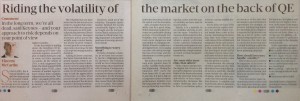Asking the Right Questions
Riding the volatility of the market on the back of QE
Article appeared in Sunday Business Post, February 8th 2015.
In the long term, we’re all dead, said Keynes – and your approach to risk depends on your point of view
So far in 2015 the financial markets can aptly be characterised by increased volatility, both in terms of the average level of volatility and the greater frequency of higher volatility.
In the first week of trading alone, the EuroStoxx 50 Index, made up of 50 Blue-chip Eurozone equities, moved by +/- 3% or more on three occasions. In the whole of 2014, it only happened 4 times. The much quoted CBOE Volatility Index (VIX), a key measure of market expectations of near-term volatility, otherwise known as the “fear index”, averaged 14.17 in 2014. It closed above 15 every day in January, with an average above 19.
The volatility that we have seen over the last month or so points to a market that is finding it more difficult to appraise the consequences of the political posturing between Greece and the Eurozone, divergent monetary policy across the world’s major central banks, the recent oil price collapse, a lower growth environment and, most concerning, the risk of Europe becoming mired in deflation.
Adding to these concerns, the Swiss National Bank surprised markets when it announced its decision to abandon its currency peg with the Euro, first introduced in 2011 at a rate of 1.20 Swiss Francs per Euro to halt the appreciation of the Franc at a time when perceived safe-haven assets were in demand. The decision to remove the peg reverberated across financial markets.
However, amid all of the volatility, European equity markets finished the month considerably higher as Mario Draghi and the European Central Bank announced the expansion of their bond buying programme, to include the purchase of sovereign government bonds.
Something to worry about?
Periods of market volatility, as we have seen recently, can be a challenging time for investors. The headline world we live in exacerbates that feeling of fear; hyperbole sells. However, it is important to remember that volatility is a natural occurrence in financial markets, it is the irrational nature of market participants that causes financial markets to be so volatile. This irrationality tends to be most prevalent in the short term, both on the upside and the downside.
Also, a healthy dose of volatility can be a good thing. When financial markets become too predictable during periods of exceptionally low volatility, they can become even more dangerous and susceptible to changing conditions. It breeds complacency among investors; encouraging excessive risk taking through the use of leverage and the investment in lower quality securities.
The reality is that over the long term (greater than 25 years), volatility looks much less frightening. During the infamous 1987 crash, the Dow Jones Industrial Average fell 22% in one day. It is just a blip on a long term chart of equity performance. Equities over the long term have been the best performing asset class, but that comes with the type of volatility we have seen in recent weeks.
Finally, it is a mistake to see volatility and risk as one in the same. Volatility is a measure of the fluctuations in the price of a financial security, which is simply a reflection of the collective behaviour of market participants at one point in time. Risk cannot be quantified by a single statistic, as much as financial practitioners try.
Are some risks more risky than others?
From a macro perspective, the biggest risk relates to the pervasive influence of central banks in the financial system and the potential long term side effects of their experimental policy decisions. The major challenge they face is how to normalise policy without causing market dislocation.
Every time we have seen a correction in equity markets the world’s major central banks have come to the rescue, reassuring investors that they won’t have to go cold turkey if the withdrawal symptoms from easy money prove too much. But the risk is that, with interest rates in the developed world still at emergency levels, these central banks will have little room to manoeuvre if another crisis hits the global economy.
As an investor, the concept of risk is a personal one. Risk allocation, how risk is allocated across a portfolio, should come before the allocation of assets, which in turn precedes the investment selection process. A suitable risk framework allows investors to better assess the personal relevance of the risks that are unique to each investment opportunity. For example, an investor holding long bonds for diversification purposes is exposed to big interest rate risk, as a rise in yields could mean losing significant capital. However, this risk is not a concern for an investor who is simply looking to match the price of annuity for retirement planning purposes.
How should investors handle volatility?
First of all, investors need to be cognisant of the limits of risk models. We do not live in a static world, even the most sophisticated economic and financial models have their limitations.
Over the last five years, investors have been well served by a long term strategic asset allocation, ignoring short term fluctuations, as equities and bonds moved higher. However, with many of the major equity indices now at record highs and bond yields at or near record lows, there is a strong case for adding a dynamic element to portfolios that can adapt to the changing environment.
At the same time, investors need to avoid the silly mistakes:
- Be realistic when it comes to return and risk expectations
- Don’t chase returns: risk must never be an after thought
- Sensible diversification – always understand what you are investing in
- Fees add up – only pay for active managers who are truly active
- Remember, there is no silver bullet!
End
Vincent McCarthy, CFA
